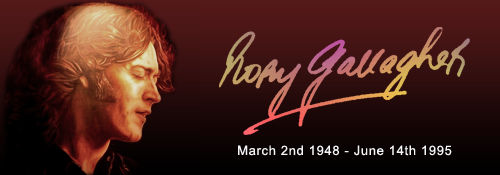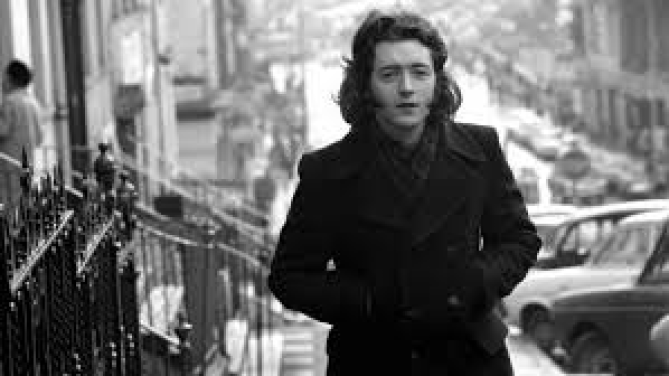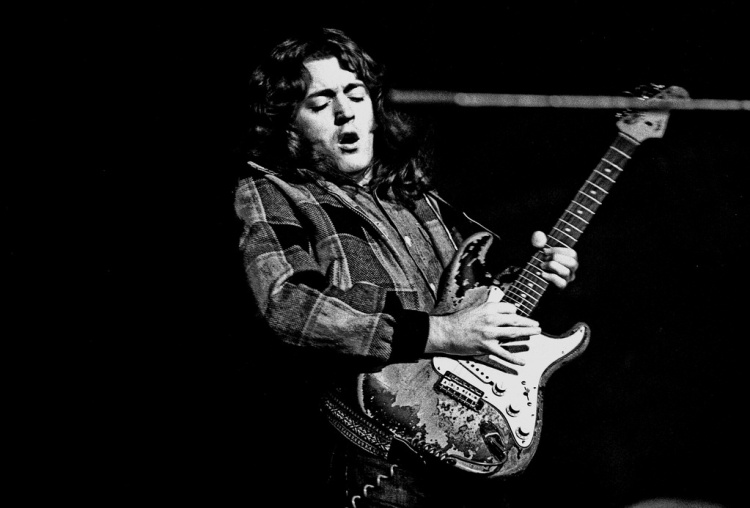 In the years that have passed since Rory Gallagher’s death, aged 47 on June 14 1995, his true stature has become ever more clear. This soft spoken Irishman, characterised by his flowing locks and trademark working man stage clothes, was far from ordinary. Gallagher was a self taught virtuoso who forged a musical revolution in his native land, shunned the traps of fame and stardom yet became a universally acclaimed international folk hero.
In the years that have passed since Rory Gallagher’s death, aged 47 on June 14 1995, his true stature has become ever more clear. This soft spoken Irishman, characterised by his flowing locks and trademark working man stage clothes, was far from ordinary. Gallagher was a self taught virtuoso who forged a musical revolution in his native land, shunned the traps of fame and stardom yet became a universally acclaimed international folk hero.
Rory’s rock solid devotion to his calling never wavered and the respect of his musical peers was universal. Eric Clapton credited Gallagher with “getting me back into the blues”, The Rolling Stones tried to get him to replace Mick Taylor.
Rory’s influence spread through the generations – from Slash to Johnny Marr, from U2’s The Edge to Queen’s Brian May, and onto The Manics’ James Dean Bradfield – any aspiring player who encountered him was bound to be energised or transformed.
Of all the guitar greats who emerged in the post war era Rory Gallagher was predestined to become a Celtic Warrior King. He shared his name with Ireland’s last native monarch, was born (to rock) at Rock Hospital in Ballyshannon, Donegal (March 2nd 1948) while his father was employed constructing a hydro electric power plant on the nearby Erne river.
 In due course, whether using electric firepower or acoustic mastery, the unassuming Gallagher would be transformed into a musical giant, yet he always maintained the most human feeling, eschewing extraneous FX and gizmos in favour of his own raw, primitive, string-bending genius. Acknowledged as ‘the people’s guitarist’ Rory would amass 20 million sales but the emotive connection he made with audiences across the globe was greater than statistics could show. Gallagher’s fire in the fingertips feel was the thrilling result of hard work and dexterity, tireless energy and dynamic drive.
In due course, whether using electric firepower or acoustic mastery, the unassuming Gallagher would be transformed into a musical giant, yet he always maintained the most human feeling, eschewing extraneous FX and gizmos in favour of his own raw, primitive, string-bending genius. Acknowledged as ‘the people’s guitarist’ Rory would amass 20 million sales but the emotive connection he made with audiences across the globe was greater than statistics could show. Gallagher’s fire in the fingertips feel was the thrilling result of hard work and dexterity, tireless energy and dynamic drive.
In addition to his facility on guitar, mandolin, and, on occasion, sax, Rory’s songwriting gifts gave perfect platform to his vocal flair and instrumental talent. Whether exuberantly unbounded (‘Walk On Hot Coals’) or reflectively subdued (the hauntingly self aware ‘A Million Miles Away’), his compositions were directed by an instinctive, natural feel for the blues that resided deep within his heart and soul.
As a pre-teen growing up in 1950s Cork, in a home with no record player, the single-minded determination that would hallmark Rory’s career quickly became apparent. The discovery of Elvis and early rock n rollers lead him to seek out blues masters on American Forces radio such as later collaborator, Muddy Waters. “The more I heard the more I got addicted,” he later recalled. He was already a local, talent show-winning star, brandishing a cheap guitar, when the first down payment was made on the celebrated 1961Sunburst Fender Stratocaster that would – its paintwork stripped by his own highly alkaline sweat – become a lifelong totemic tool of his trade.
In early 60s Ireland opportunities for a guitar God waiting to shine were constricted by the only available outlet : identically suited showbands. Rory pushed against the envelope when he hit the road with The Fontana and later The Impact challenging the accepted routines of the day.
His sensational displays of unfettered magic on the fretboard may have earned rebukes from local promoters and Ballroom owners keen on regimentation but Rory assuredly made lifelong fans in audiences hungry for a new sort of freedom. Playing in show bands was a stepping stone and Rory realised he was “only passing through”. But, like Jimi Hendrix when he escaped the chitlin circuit, the skills established as a restricted sideman would explode in the years ahead when Rory became the main attraction. After enjoying the release of playing in Hamburg clubs, Rory seized the opportunity to get off the show band leash back home, putting himself centre stage in the power trio, Taste.
Establishing a base in the thriving Blues scene that had built around Van Morrison’s Them at Belfast’s Maritime, Taste became an instant sensation. A residency at London’s Marquee club in 1968, where John Lennon joined an ever growing fervent following, lead to support slots with Cream and Blind Faith. Taste’s formidable presence was captured on two great studio albums and two outstanding live albums including their Live At Isle of Wight album, recorded at the 1970 festival. Then, with their world seemingly at their feet Taste, torn apart by management disputes, imploded, playing their farewell show in Belfast on New Years Eve 1970.
The loss of a band at their incandescent peak hit Rory deep (check the aching ‘At The Bottom’, on his 1975 ‘Against The Grain’ album) but there was little time to dwell in regret (‘Used To Be’ on ‘Deuce’ 1972). A natural bandleader, Gallagher regrouped embarking on the most productive decade of his solo career with 1971’s self titled solo debut. ‘Deuce’, ‘Blueprint’, ‘Tattoo’, ‘Against The Grain’, ‘Calling Card’, ‘Photo Finish’, ‘Top Priority’ – the albums followed in quick succession each offering original compositions (‘In Your Town’, ‘Who’s That Coming’, ‘Walk On Hot Coals’, ‘Tattoo’d Lady’) that spoke directly to his audience, attained instant classic status . These songs and many more would gather even greater vibrancy in live performance. The albums ‘Live In Europe’, ‘Stagestruck’ and ‘Irish Tour ‘74’ albums show how.
As witnessed in the exceptional Tony Palmer documentary that accompanied the Irish Tour ‘74 release, throughout ‘the troubles’ Rory’s Belfast shows galvanised a joyful communal riposte to the tension, fear and divisions that tore the city apart. Where others shunned the Northern Irish capital, Gallagher made a point of always returning, giving hope and inspiration, to those who would follow his lead. Rory would later guest on albums by Belfast bands he directly inspired – Energy Orchard and Stiff Little Fingers.
Across the border he headlined and organized Ireland’s first outdoor rock festival at Macroom in tandem with younger brother and manager Donal (Rory’s only sibling), an event that would pave the way for U2’s stadium rock. Yet Rory’s quasi evangelical belief in the unifying healing power of music was tempered by a suspicion of celebrity. “It seems a waste to me to work and work for years, really gettin’ your music together; then to make it big, as some people do, and just turn into some sort of personality. You play less, you perform less, you circulate less. It becomes something completely different,” he’d told Rolling Stone in 1972.
This caution left him to completely shun the singles market, even when his label boss insisted the gorgeous yearning Edged In Blue (from 1976’s ‘Calling Card’) was a contender for US number one. The body of work he has left behind is remarkable for its consistency, honesty and earthiness. Rory’s recordings are remarkably of a piece bearing out his oft quoted assertion that “what I play is in my all the time, not just something I turn on”.
A determination to make original music that stayed faithful to the root sounds that inspired him was carried through to the end. Unsullied by jarring studio trickery or momentarily fashionable techniques, cavernous drum sounds or click tracks, what he’s left behind is a recorded legacy defined by rugged purity of form and feeling. The unaffected approach highlighted the many flavours – kick ass country, jazzy sophistication, spit n sawdust folk, floorboard quaking roof raising rock – that fed Rory’s lovingly nurtured blues. His dedication to maintaining what he called “a good vintage, ethnic” sound, favouring pre digital over modern recording equipment, would undoubtedly have been one of the attributes that endeared Rory to admirer Bob Dylan, a backstage visitor at a 1978 LA show after initially being turned away unrecognized. Gallagher’s yearly gig quota often would top 300, sweat soaked nights in which he never gave anything less than 110 per cent . And he was always ready to give a little more, come Christmas time he would often embark on impromptu tours in rural Ireland which naturally attained legendary status. A cross tribal musical hero who appealed to trad rockers, punks and heavy metal hordes, Rory was a true musical journeyman going where the music took him. He guested on albums for many including key influences Jerry Lee Lewis, Albert King, Albert Collins and the aforementioned Muddy Waters, an experience he particularly relished.
By 1990 Rory had played 25 stateside tours and appeared at the UK’s Reading festival and Montreux Jazz festival more times than any other act. Sadly, he swelled up as drink and various prescription medications to deal with the rigours of life on the road had prematurely and noticeably aged him. “The blues is bad for your health,” he shrugged, “its as simple as that, it goes with the territory.”
Breaking away from major label and setting up independently, Rory’s output had become less prolific as he increasingly agonized over recordings. Even so later albums ‘Jinx’, ‘Defender’ and ‘Fresh Evidence’, the last release before his death, showed him still moving forward, breaking new territory. The soaring ‘Loan Shark Blues’ is a timelessly potent cry of financial desperation while ‘Heaven’s Gate’ and ‘Ghost Blues’, the title of Ian Thuiller’s excellent career spanning 2010 Gallagher documentary, cut from the same self revealing cloth as ‘A Million Miles Away’, contemplated life’s fragility. His dedication to the muse was absolute, perhaps at a cost to his personal life: he had no marriage, no long-term relationship and no children. The man who could unite thousands in performance lived a solitary unindulgent life away from stage, seeming to identify with the solo operatives who peopled the noir detective fiction of such as Dashiell Hammett from which he often took lyrical inspiration. So tied was he to life on the road that his final years were spent living in a hotel overlooking Chelsea harbour. Rory literally played until he dropped, after collapsing onstage in Rotterdam in January 1995, he was hospitalised in London with liver failure. Following a successful transplant operation he seemed to be recovering, but he caught an infection and died in June 1995.
The music world sent their condolences, 15,000 lined the streets of Cork as he was laid to rest. But Rory’s dedication to the rock’s skills base would also see him teach a budding player how to play a riff or get a certain sound – Brian May was one such beneficiary – and he took pride in founding the still prominent Registry of Guitar Tutors.
Since his death Rory’s reputation has grown. Perhaps its only with the passing of the time that the sheer scope and immensity of his achievements can be assessed. A true original his resolutely ordinary working man image, the unvarnished consistency of his art (and his paint stripped Strat!) appears all the more extraordinary in the era of media saturation. In 2003 the posthumously released ‘Wheels Within Wheels’ album provided another career highlight, focusing on the acoustic side of Rory’s art featuring collaborations with Martin Carthy, Bert Jansch, Lonnie Donegan, Flamenco great Juan Martin and The Dubliners. This year sees the first ever release of the abandoned 1978 album recorded in America ‘Notes From San Francisco’. Rory’s memory lives on across the globe, in the memory of those who experienced his shows and met him. Legions are the fans who , like a young aspiring Manchester guitarist Johnny Marr in the early 70s, cherished meeting Rory and came away walking on air. More than once in the heat of a show where stage invasions were commonplace the Strat would be handed to an audience member for a quick strum. The feeling he could create in a hall in Belfast or Montreux, in London or LA, you couldn’t ask anymore from a gig, really.
Gallagher is commemorated throughout Ireland, a bronze statue in Ballyshannon, a sculpture in Cork where the local theatre is named after him, a mounted guitar in Dublin, a plaque in Belfast and his famously battered paint stripped Sunburst strat has been marketed by Fender in a tribute model. There’s a Rue Rory Gallagher in Paris, an annual festival in Ireland and tribute concerts held each year in his honour around the world. Rory’s story, it seems, will not end. Readily accessible on awe inspiring live performances preserved on a wealth of DVDs, a comprehensively curated official website and remastered recordings – a legacy lovingly maintained by his family, brother Donal and nephew Daniel, his music remains ready to inspire and thrill generations old and new.
Rory Gallagher died too young with much still to achieve and offer but the wealth and quality of the material he produced in his lifetime insures his ever questing, hungry spirit lives on.
(c) http://www.rorygallagher.com

